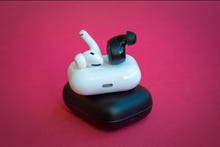[embedded content]
The tough thing about competing with Apple in the mobile space is not how well the iPhone has continued to sell (very well), but how effectively the company has capitalized on that success to achieve a strong position in categories that — like smartphones — might not have got off the ground were it not for Apple’s entry. The most natural extensions of these have been AirPods and the Apple Watch that are still in the early days of a triad of personal technology, one that will clearly evolve in the next few years to represent a triad that acts more like one holistic system than three separate products.
Earbud competitors have fared better than smartwatch competitors. Consumers can more easily understand their value; they are simpler products than smartwatches, platforms with a strong fitness bent. And even with Apple getting more aggressive on pricing with the launch of the Apple Watch SE, smartwatches remain, on average, a more expensive category than true wireless earbuds. Many luxury brands such as Movado, Montblanc, and Tag Heuer on the Android Wear menu.
But while AirPods work (pretty well) with devices outside the Apple ecosystem, they of course work better within it, in part because Apple controls both that product and the iPhone most often used with it. Now, Qualcomm is trying to replicate or even exceed that level of integration with Qualcomm Snapdragon Sound (QSS). The initiative aims to not only exceed Apple’s standards for features such as connectivity, latency, and audio quality but continue Qualcomm’s long-running war against wires in matching the reliability and audio quality of wired headphones.
The initiative will get off to a slow start, as QSS requires the Snapdragon 888, Qualcomm’s flagship, although it will surely move forward to flagships and will likely come down into less premium product families. The 700 series seems highly likely, particularly because of that chip’s push into the gaming market, as does the 600 series given its volumes. Beyond that, Qualcomm must weigh the payoff of penetration as it competes primarily with MediaTek for lower-end phones.
But, whatever the compatible phone, Qualcomm’s consumer advantage lies in the variety of earbuds that can be expected to support the standard. They come in two camps: Established audio and accessory brands (Bose, Bang and Olufsen, and Anker) and smartphone brands (OnePlus, LG, and Nokia). Particularly for premium brands, as represented by Audio-Technica at the launch, QSS’ support of high-resolution audio via services such as Amazon Music in a world moving to Wi-Fi 6e and 5G, the timing is great to show off the acoustic expertise that has made them famous.
For the smartphone brands, as represented by Xiaomi at the launch, QSS helps facilitate smartphone-earbud bundles (particularly useful as the headphone jack fades) and along the journey toward offering their own personal tech triad. A good example of this is Vivo, the Chinese smartphone brand that recently launched the specced-to-impress Neo earbuds. (They’re not QSS-certified, but future iterations might be.) If more hop on board QSS, the earbuds that are most squeezed could be audio brands trying to compete on price.
QSS also represents a shift for Qualcomm, which has a long history of both selling its FastConnect chips and licensing technologies such as aptX to headphone makers. While its customers will continue to offer and promote those technologies, QSS is meant to communicate an experience enabled by integration and could pave the way for similar efforts where the company has a strong position at multiple ends of a connection, notably Wi-Fi networks.
PREVIOUS AND RELATED CONTENT
Qualcomm announced Snapdragon Sound: hardware and software offer optimized audio experiences
Qualcomm is known for its processors powering the world’s smartphones and with today’s announcement it continues to improve end-user experiences, this time in way of audio performance. Launch customers include Xiaomi, Audio-Technica, and Amazon Music.
5G and Wi-Fi 6: Unlikely allies
Before the pandemic, telcos pondered how to sell 5G fixed wireless so convincingly that consumers would willingly ditch their Wi-Fi routers. Now that Wi-Fi is everyone’s best friend, that strategy has pivoted completely.
Why buy AirPods? Great earbuds don’t have to cost $250
Apple’s AirPods and AirPods Pro have become synonymous with quality earbuds, but you can grab the high-quality Soundcore Life Dot 2 earbuds for under $50.





















